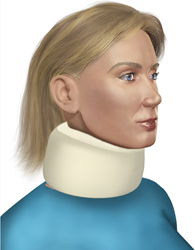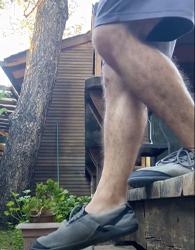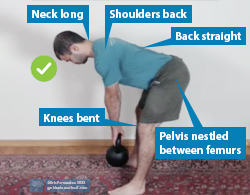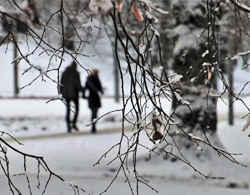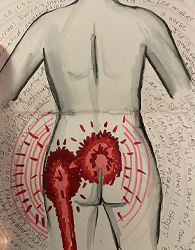Do you suffer from neck tension, muscle knots, or tingling in your fingers? Do you get frequent headaches?
Or maybe your neck is fine most of the time, but seizes up periodically, leaving you unable to function normally in your job, family life, and recreational activities.
Most neck pain involves compression.
In modern cultures, the head often drifts forward as we slouch and crane our necks towards our computer screens. The weight of the head, (typically 11 lb. or 5 kg—think bowling ball), then requires the muscles at the back of the neck to contract strongly to keep the head up. This contraction compresses the relatively delicate tissues in the area. Not a recipe for a healthy, happy neck. If you have forward head carriage but are symptom-free so far, keep reading for tips that will prevent future problems with the discs, nerves, blood vessels, and bones in your neck.
Get Updates on the Latest Blog Posts
Welcome to our second post on navigating steps and stairs. Our first post looked at how to power yourself up stairs—however, we often hear from our students that their most pressing concern is how to come down stairs.
Are you starting to worry that you may need to set up your bedroom downstairs, or find yourself compromised when visiting places with stairs? Perhaps you have a friend or older relative in this position? Is it possible to maintain or even improve your fitness and mobility in the years ahead? “Life exercises” such as descending stairs, done skilfully, can be transformative and can give many benefits beyond getting you where you want to go.
We’re a month into the New Year—and that has me thinking about what helps us to keep going and succeed with our New Year's resolutions. Including our posture and exercise goals.
One thing that I have found works well for me, and for my students, is to choose my words carefully.
Choosing words with care
The words we use can be extremely powerful. They can shift your mindset from negative to positive. We may not even realize that we have disadvantaged ourselves with a mental framework of negative words and phrases until we gain a fresh perspective. These frameworks can go back so many years we have mistaken them for a permanent part of ourselves.
Some of our self-talk goes back to our childhood. Our parents of course do their best for us, but parenting in our culture is often an isolated, poorly supported, and arduous journey. Parents’ anxieties, prejudices, and even best intentions are often embedded in negative language and unwittingly passed on to us. Over the years I have seen how many students have internalized their parents' criticism. I encourage students to let this go. It’s a disservice to yourself.
Before I settle in to recount my back pain story, let me fetch my Gokhale Pain-Free™Chair. This is the chair I now use for all my writing, and that’s important, as I am an author of mystery short stories, and spend many hours composing at my desk. Pain-free, I’m now glad to say.
We’re here to help with your New Year’s fitness resolution. Join us for a FREE 10-day New Year 3 x 3 Fitness Challenge, which is offered as part of the Gokhale Exercise program. It will be fun, safe, and effective, enabling you to build your strength without strain and injury, because, all the while, you are also training for healthy posture!
Yesterday was midwinter day in the northern hemisphere. For many of us, this time of year means colder, shorter days, and a time when outdoor activities and social get-togethers can be more limited.
Get out walking
One thing we can do whatever the season is to get out on foot. Walking, done well, can significantly boost our circulation, burn calories, keep us warm, and assist our digestion—especially useful after rich and large festive meals! A good walk will also fill our lungs with fresh air and can boost our immune system to fight off winter bugs.
Such exercise, especially in nature, is known to lift our mood. We can enjoy the company of friends and family—or go solo for some peace and introspection, as fits. All these potential benefits and more are summed up in the Latin phrase, Solvitur Ambulando, which translates as “walking solves everything.”¹
Few of us, wheelchair users excepted, pass a day without climbing steps or stairs. Students often ask if posture has any bearing on how best to do this—and the answer is yes! Our approach to pain-free, healthy posture works precisely because it helps you with all your daily activities. This blog post is the first of several containing introductory tips for using steps and stairs. We will focus here on how to power yourself upward.
Steps and stairs—the benefits
If you are looking to maintain or improve your cardio fitness and lower body strength, climbing steps and stairs will check that box. For example, this could be opting for the stairs rather than the elevator at work.
There are so many things in my life that I feel thankful for, and Thanksgiving gives an opportunity to reflect on these feelings of gratitude. For our newsletter I wanted to share the deep gratitude I have for my personal journey out of back pain, and for how that journey continues as a growing ability to support and empower others in this direction.
When I came to write this blog post, I quickly realized that this is a daunting task! The truth is that so many people have played invaluable parts, both great and small, in helping me to create the Gokhale Method® that it’s impossible to pay tribute to everyone in a short piece of writing. So I decided there will be other posts of gratitude, including to my teachers, to the people around the globe on whom this work is based, and to our team of dedicated teachers and staff. But on this National Day of Thanksgiving, I’d like to focus on things related to living and working in the US.
My name is Sheila Bond, and I am an artist, knit and jewelry designer, and an art teacher. I am also the mother of four sweet kids. In this blog post I would like to share with you my Gokhale Method® journey out of pain and despair.
On May 6 2022 I severely herniated the spinal disc between my L4/L5 vertebrae. In addition I had developed bursitis in my left hip during the previous three months, I believe from sitting improperly teaching online classes.
It happened on the Friday before Mother’s Day. By Saturday morning I could barely move and thought I might die or at the very least never recover. I ordered a TENS unit (transcutaneous electrical nerve stimulation, a mild electrical current to give pain relief) from Walgreens, bought Salonpas patches too, and a walking cane. I took three Advil or two extra strength Tylenol alternating every six-hours hours.
I had previously herniated my L4/L5 in 2015, and had a laminectomy (a surgical operation to remove part of the back of vertebrae, usually to relieve pressure on nerves.) That surgery had left me still in terrible pain. When I told the surgeon I was still in pain in my tailbone/sacrum area, he told me he could operate on my tailbone. I declined. Following surgery I also went to physical therapy for a year and a half. It gave me more pain than it took away.

